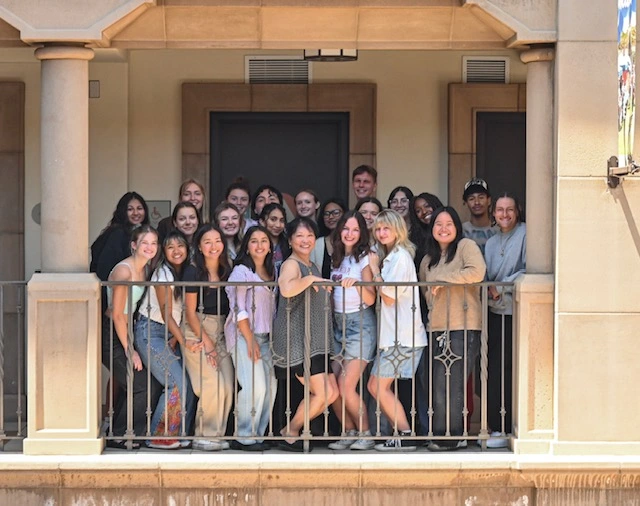The Hindu festival of new beginnings
Satvika Nitya / A&C Editor
Every year, during the months of August and September, the Hindu calendar brings around one of the most widely celebrated 10-day festivals called Ganesh Chaturthi. Hinduism is a religion that leads with the principle of finding divinity in the common and this festival is a time when Hindus worldwide take a moment to recognize fresh beginnings and pray for the clearance of obstacles through rituals, prayers, dancing and — in true Hindu fashion — a platter full of delicacies.
Hinduism is a religion that is studded with a long list of deities, each of them being looking after one or more parts of human nature and life. The point of Ganesh Chaturthi, also known as Vinayaka Chavithi, is to celebrate the birth of the elephant-headed God Ganesha, who is known to be the destructor of obstacles: God of new beginnings, wisdom and prosperity. It is in Hindu tradition to worship Ganesha before the start of a new period in your life, whether that be going off to college or buying a new car.

Photo courtesy of @thegreatbappa/Instagram
Asking for his blessings is like a rite of passage into a world free of sin and filled with knowledge.
During the 10 days that this festival is commemorated, it is said that Lord Ganesha descends down to Earth to bless his worshipers. So in order to invite him into their homes, devotees buy a statue or idol of Ganesha and place it on a higher pedestal embellished with flowers, turmeric, sandalwood paste and — most importantly — surrounded with food.
According to Hindu mythology, Lord Ganesha was a lover of sweet delicacies and was even named “Modapriya” because of his love for Modaks, a steamed dumpling with coconut-jaggery stuffing. This connection to food is one of the main reasons why Ganesh Chaturthi brings about awidespread feeling of community. People will often bring sweets and cook food to bring to friends, family and even strangers who celebrate the festival.
Since most Hindus live in India, a vast and extremely diverse country, the way one’s family celebrates the festival varies according to the environment in which they grew up. And the most grand celebrations today happen in West India, in the state of Maharashtra.
USD international graduate student Aashruti Seervi shared her memories of observing Ganesh Chaturthi during her time in India as she movedfrom one state to another.
“Growing up in Rajasthan, I celebrated the festival, just not as much as it was in Maharashtra. But I have really positive memories of decorating the pedestal, eating the sweets and worshiping with my family,” Seervi said. “But once I moved for college to Bangalore, since India is very diverse, celebrating with friends and people coming from different backgrounds made it feel so much bigger and gave me a sense of belonging.”
Bigger celebrations of Ganesh Chaturthi involve activities and festivities on all 10 days. From dance performances and bingo games for elders to dinner nights and daily group prayers, the festival is celebrated both on an individual and community level.
Gigantic elaborately-crafted statues of Lord Ganesha are beautifully set up in public places across cities, and devotees make it a point to go see thesestatues during the 10-day period.
On the last day of the festival, it is finally time for Lord Ganesha to depart after his time on Earth and this day is a culmination of the entire festival. Idols of Ganesha are brought together from individual homes and set up with larger statues, as they are paraded through the streets accompanied by music and dancing. Musicians play a double- headed drum that is worn around the shoulders using a strap called a ‘Dhol’ as worshippers dance and celebrate Ganesha’s departure.
“Dancing on the Dhol is one of my best memories,” Sreevi said. “It is crazy. We are out on the streets, dancing like crazy, sweating. It is so fun, especially with a group of friends.” The idols and statues are then immersed into bodies of water like rivers, ponds or even large buckets of water in order to bid farewell to Ganesha as devotees show gratitude for his blessings and pray for an early return the yearafter. This immersion of idols into water is called “Visarjan” and is not just a symbol of goodbye but also helps drive the idea that life is in a constant state of change, as new beginnings always arise.
The sentiment of celebrating this festival changes and varies for Hindus around the world. USD junior Advika Pillai talked about her relationship with the festival as someone who grew up in the U.S.
“I definitely think it’s very different, because in India you have an entire community,” Pillai said. “Growing up, it was just me and my family celebrating it, and my friends were doing it with theirs. And being in the U.S., I definitely feel like I am more Hindu when I’m with my family who actively practice it and not as much when I am in college. But still I feel the sentiment. I have a little Ganesha idol in my room and in my car, and I definitely want to know and keep in touch with my religion more.”
Pillai recounted a story during her senior year of high school when she was on a long road trip with her friends and the Ganesha idol in her car fell down, a symbol that is usually considered a bad omen. Coincidentally, the trip was filled with obstacles like flat tires and Pillai remembered the trip feeling surreal and was amazed at the timing of events.
Regardless of where one grows up, the grandness and gravity of Lord Ganesha is felt by Hindus everywhere, especially during Ganesh Chaturthi. This year, this auspicious festival occurred on Sept. 19, offering a chance for people to have a new beginning, free of struggles and stones, right at thestart of a new academic year.





Leave a comment